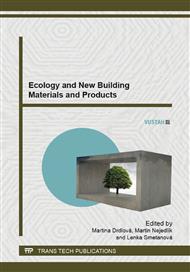[1]
L.K. Herrera, H.A. Videla, The importance of atmospheric effects on biodeterioration of cultural heritage constructional materials, Internal Biodeterioration & Biodegradation, Vol. 54 (2004) p.125–134.
DOI: 10.1016/j.ibiod.2004.06.002
Google Scholar
[2]
C.C. Gaylarde, L.H.G. Morton, K. Loh, M.A. Shirakawa Biodeterioration of external architectural paint films – A rewiev. International Biodeterioration & Biodegradation, Vol. 65 (2011) p.1189–1198.
DOI: 10.1016/j.ibiod.2011.09.005
Google Scholar
[3]
P.M. Gaylarde, C.C. Gaylarde Algae and cyanobacteria on painted buildings in Latin America. International Biodeterioration & Biodegradation, Vol. 46 (2000) p.93–97.
DOI: 10.1016/s0964-8305(00)00074-3
Google Scholar
[4]
M. Rulik, V. Holá, F. Růžička, M. Votava Mikrobiální biofilmy/Microbial biofilms (in Czech), Palacký University Olomouc, Faculty of Science, Olomouc 2011, ISBN 978-80-244-2747-8.
Google Scholar
[5]
X. Arino, A. Gomez-Bolea, C. Saiz-Jimenez Lichens on ancient mortars, International Biodeterioration & Biodegradation, Vol. 40 (1997) p.217 – 224.
DOI: 10.1016/s0964-8305(97)00036-x
Google Scholar
[6]
M. Muroňová Aerophytic cyanobacteria of Ubatuba area, Mata Atlantica, Brazil. Bc. thesis, in Czech] University of South Bohemia, Faculty of Biological Sciences, České Budějovice. 32 pp.
Google Scholar
[7]
G. Vishal, K.R. Sachitra, A. Sood, V. Chaudhary, R. Prasana, New insights into the biodiversity and applications of cyanobacteria (blue-green algae) – Prospects and challenges, Algal Research, Vol. 2 (2013) p.79–97.
DOI: 10.1016/j.algal.2013.01.006
Google Scholar
[8]
H.W. Bischoff, H.C. Bold Phycological studies, IV, Some soil algae from Enchanted Rock and related algal species. Univ. Texas. Publ. 6318 (1963) 1–95.
Google Scholar
[9]
F. Hinďák, Z. Cyrus, P. Marvan, P. Javornický, J. Komárek, H. Ettl, J.K. Rosa, A. Sládečková, J. Popovský, M. Punčochářová, O. Lhotský, Sladkovodné riasy, SPN Bratislava, 1, (1978) p.728.
Google Scholar
[10]
J. Komárek, T. Hauer, (2008), CyanoDB. cz – Online database of cyanobacterial genera, Information on http: /www. cyanodb. cz.
Google Scholar
[11]
T. Hauer, M. Pažoutová Ephilithic cyanobacteria in selected localities in Krkonoše MTS, Opera Corcontica Vol. 46, (2006) p.57–66.
Google Scholar
[12]
F. Hinďák, J. Komárek, I. Pišůt, V. Peciar, M. Červenka Malý kluč výtrusných rastlín, SPN Bratislava, (1965) p.437.
Google Scholar
[13]
C.A. Crispim, P.M. Gaylarde, C.C. Gaylarde, B.A. Neilan Deteriogenetic cyanobacteria on historic buildings in Brazil detected by culture and molecular techniques. International Biodeterioration & Biodegradation, Vol. 57 (2006) p.239–243.
DOI: 10.1016/j.ibiod.2006.03.001
Google Scholar
[14]
C.A. Crispim, P.M. Gaylarde, C.C. Gaylarde Biofilms on church walls in Porto Alegre, RS, Brazil, with special attention to cyanobacteria, International Biodeterioration & Biodegradation, Vol. 54 (2004) pp.121-124.
DOI: 10.1016/j.ibiod.2004.03.001
Google Scholar
[15]
R. Wasserbauer, Z. Rácová, I. Loušová Vliv společenstva řas a bakterií na tvorbu korozivně aktivních sloučenin, které degradují silikátové stavební materiály/The effect of algal and bacterial communities on the formation of corrosion active compounds that degrade silicate building materials (in Czech), (2013).
Google Scholar
[16]
W.D. Muynck, A.M. Ramirez, N. D. Belie, W. Verstraete Evaluation of strategies to prevent algal fouling on white architectural and cellular concrete. International Biodeterioration & Biodegradation, Vol. 63 (2009) 679–689.
DOI: 10.1016/j.ibiod.2009.04.007
Google Scholar
[17]
Laiz, L., Romanovska-Deskins, A., Saiz-Jimenez, C. Survival of bacterial/archaeal consortium on building materials as revealed by molecular methods, International Biodeterioration & Biodegradation, Vol. 85 (2011) p.1100–1103.
DOI: 10.1016/j.ibiod.2011.04.010
Google Scholar



